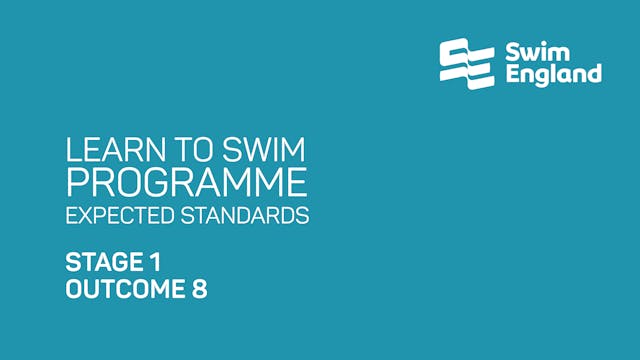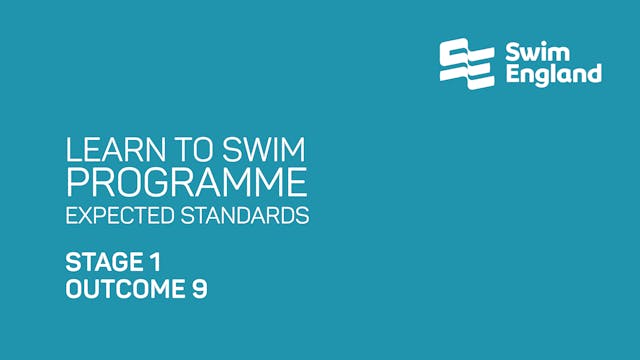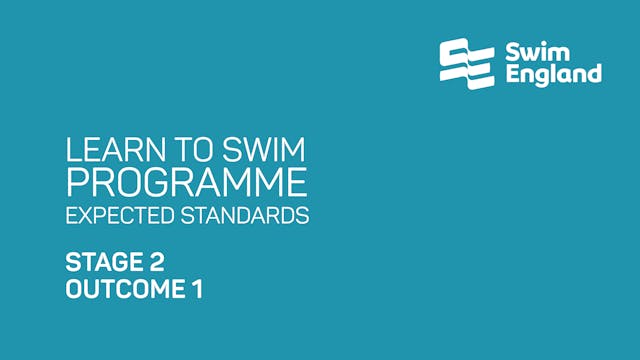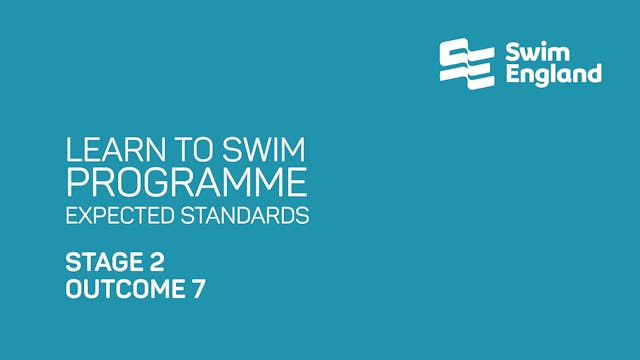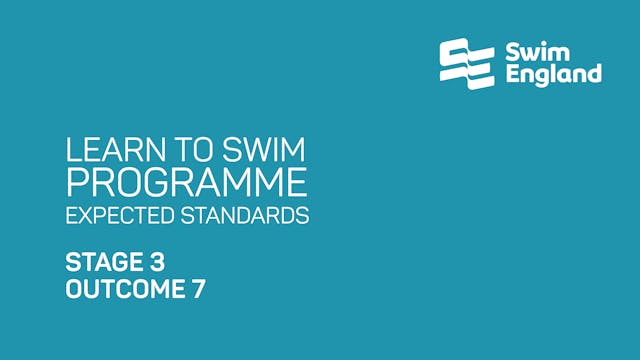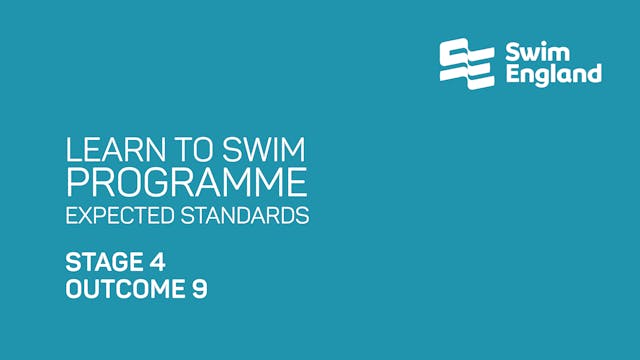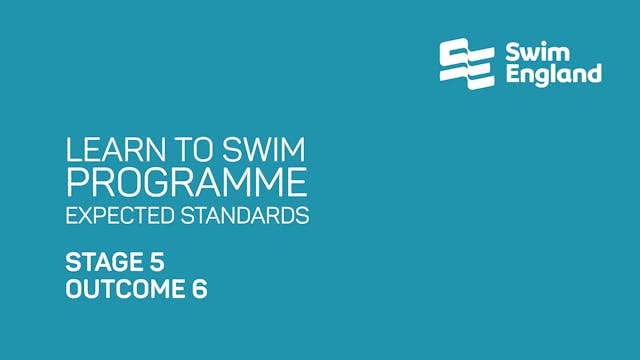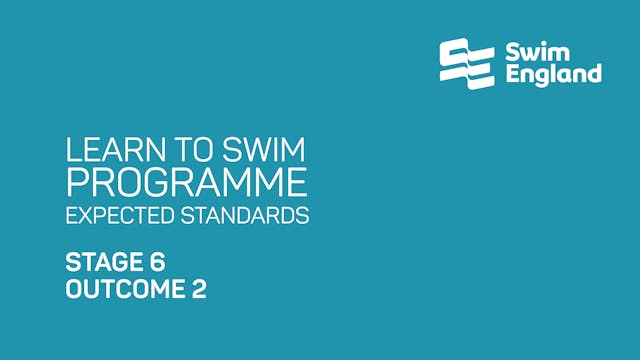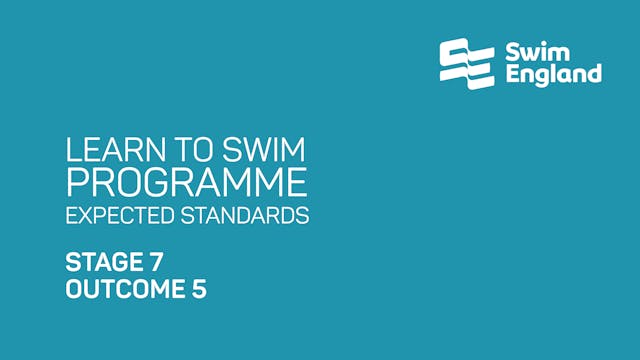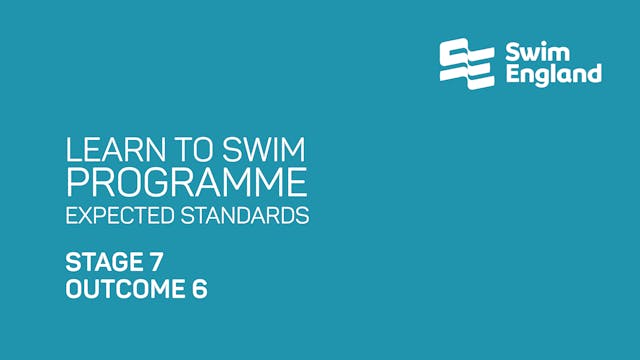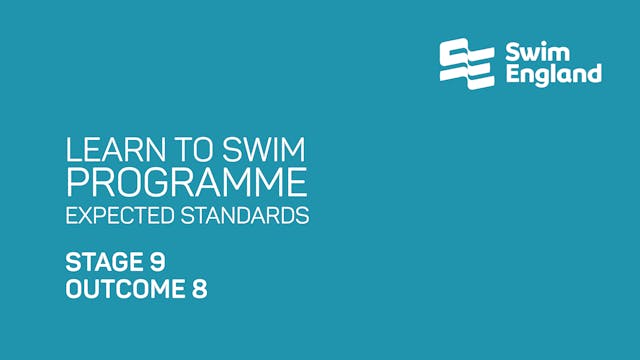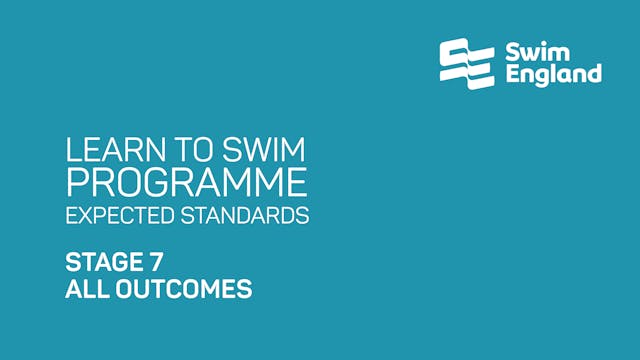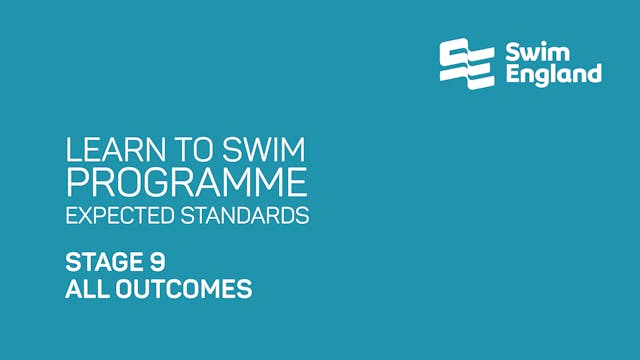Water Safety and LTS Expected Standards bundle
The Swim England Water Safety Awards are ideal for children who are taking part in the core Learn to Swim Stages 1-7 of the Swim England Learn to Swim Programme. There are three Water Safety Awards teaching water danger awareness, self-rescue techniques and vital survival skills in clothes, without swimming goggles.
The Swim England Learn to Swim Framework is about developing confident and competent learners through fun and enjoyment, with Stages 1-7 being the core of the Programme. It is the most widely known Framework for swimming lessons for children and is the backbone of swimming lessons for primary school aged children.
Swim England recognises that some learners may not be able to perform these outcomes identically to what is shown in the video. Swimming teachers have the responsibility to ensure that high standards are maintained. Learners should perform the skill or stroke as close to the intended outcome as their abilities allow.
This content may be used by you or your employees and be displayed for the benefit of students you are teaching. You may not otherwise copy, reproduce, distribute, publish, display, perform, modify, create derivative works, transmit or in any other way exploit this content or any part thereof without prior permission of Swim England.
-
Water Safety Award 1 Outcome 1
Perform a swivel entry. Learners sit on poolside, place hands together on one side of the body, turn onto the tummy and slide into the water. Hands maintain contact, with the poolside or rail.
Swim England recognises that some learners may not be able to perform these outcomes identically to wha...
-
Water Safety Award 1 Outcome 2
Jump in and immediately rotate 180 degrees to travel back to the side. Start with toes over the edge of the pool, jump upwards and forwards whilst eyes are looking forward throughout; land feet first in the water and allow the body to fully submerge. Once in the water, rotate and return to the si...
-
Water Safety Award 1 Outcome 3
Float on the back for 30 seconds. Learners must adopt a star float or other floating position on the back, whilst moving as little as possible. The importance of this is to show how to survive the initial cold water shock phase of immersion/submersion.
Swim England recognises that some learners...
-
Water Safety Award 1 Outcome 4
Fully submerge, exhale and resurface. Learners must submerge under water, exhale slowly and return to the surface.
Swim England recognises that some learners may not be able to perform these outcomes identically to what is shown in the video. Swimming teachers have the responsibility to ensure t...
-
Water Safety Award 1 Outcome 5
Log roll from floating on the front to floating on the back. Learners perform a log roll from a flat floating position on the front onto the back (arms can be by the side or above the head), before returning to an upright position (floating or standing depending on the depth of the water).
Swim...
-
Water Safety Award 1 Outcome 6
Tread water in an upright position for 10 seconds without flotation equipment. The body must be upright with the head clear of the water. Movements made must be stress-free and relaxed. Learners may use a variety of kicks including scissor kick, running type action, breaststroke kick and eggbeate...
-
Water Safety Award 1 Outcome 7
Perform a signal for help on the back, whilst holding onto flotation equipment. Learners adopt a floating position on the back comma holding flotation equipment across the tummy. They then raise one arm above the head while shouting for help. Learners must appear at ease when performing this acti...
-
Water Safety Award 1 Outcome 8
Exit the water safely without support. Learners may make use of ladder or steps or a beach pool graduated exit or climb.
Swim England recognises that some learners may not be able to perform these outcomes identically to what is shown in the video. Swimming teachers have the responsibility to en...
-
Water Safety Award 1 Outcome 9
Show an understanding of water safety. Understanding can be assessed through question and answer sessions.
Swim England recognises that some learners may not be able to perform these outcomes identically to what is shown in the video. Swimming teachers have the responsibility to ensure that hig...
-
Water Safety Award 1 (Full Video)
During this Award your child will learn basic water safety awareness and survival techniques such as floating, treading water and submerging and resurfacing, without goggles.
Swim England recognises that some learners may not be able to perform these outcomes identically to what is shown in the ...
-
Water Safety Award 2 Outcome 1
Perform a fall in entry. Stand sideways on poolside or with the back facing the pool. Lean forwards and make a ball with the body, tucking the chin into the chest, bringing the knees up, toes pulled upwards towards the body and falling backwards or sideways into the pool. The forearms are pressed...
-
Water Safety Award 2 Outcome 2
Float on the back for 60 seconds without floatation equipment and explain why this is important. Learners perform a star float on the back with arms and legs extended. A star float is preferred because it allows for minimum movement while overcoming the effects of cold water shock. Eyes should be...
-
Water Safety Award 2 Outcome 3
Tread water for 30 seconds without flotation equipment. The body must be upright, with the head clear of the water. Movements made must be stress-free and relaxed. Learners may use a variety of kicks including scissor kick, running-type action, breaststroke kick or eggbeater kick. Hands must rema...
-
Water Safety Award 2 Outcome 4
Perform a rotation of 360 degrees whilst treading water without flotation equipment. Learners rotate 360 degrees in an upright position whilst treading water. The body must be upright, with the head clear of the water. Movements made must be stress-free and relaxed. Learners may use a variety of ...
-
Water Safety Award 2 Outcome 5
Signal for help whilst treading water without floatation equipment. Learners are in the water, treading water to stay afloat without floatation equipment. They must raise one arm above the head whilst shouting for help. Learners must appear at ease in performing this activity.
Swim England recog...
-
Water Safety Award 2 Outcome 6
Swim on the front for 10 metres, log roll onto the back and then rest for 60 seconds; return to an upright position to tread water. Learners travel for 10 metres on the front using either head up front crawl or breaststroke; then log roll onto the back to rest for 60 seconds in either star float ...
-
Water Safety Award 2 Outcome 7
Swim 10 metres on the front, log roll and swim 10 metres on the back to a floating object. Learners should travel on the front using head up front crawl or breaststroke, rotate using a log roll onto the back and continue to travel backstroke for 10 metres to collect a floating object such as a ba...
-
Water Safety Award 2 Outcome 8
Swim for 10 metres towards the side of the pool using long arm front paddle (survival stroke). Learners swim for 10 metres on the front with an alternating leg kick, pulling with alternative arms. Arms are under water and chin is on the surface.
Swim England recognises that some learners may not...
-
Water Safety Award 2 Outcome 9
Fully submerge to the pool floor; rhythmically bounce from the pool floor to the surface to take a breath; re-submerge. Repeat four times. Learners should be in at least shoulder depth water so that they can safely fully submerge. When under the water the learner should fully exhale slowly and re...
-
Water Safety Award 2 Outcome 10
Demonstrate the heat lessening position. Brackets help with a floating object. Holding a buoyant object such as a float firmly, learners should draw the knees up to the chest, keeping the legs pressed together to retain body heat. The head should stay clear of the water and. Arms should be held c...
-
Water Safety Award 2 Outcome 11
Learners should keep the body straight and lean slightly backwards. Climb out from the side, without using the steps. Learners climb out onto the side of the pool. To climb out from the side, the hands should be placed close to the edge of the pool, palms flat and the body weight lifted onto the ...
-
Water Safety Award 2 Outcome 12
Recite and show understanding of the four key water safety messages. Learners must be able to recite the four key water safety messages:
1. Always swim in a safe place
2. Always swim with an adult.
3. If you fall in, float, breathe, relax.
4. If someone else is in trouble, call 999/ 112.U...
-
Water Safety Award 2 (Full Video)
The outcomes of this Award should be performed in water of at least full reach depth, without goggles and light clothing (shorts and t-shirt).
Swim England recognises that some learners may not be able to perform these outcomes identically to what is shown in the video. Swimming teachers have th...
-
Water Safety Award 3 Outcome 1
Perform a straddle entry. Learners stand on the side of the pool with one foot in front of the other. The front foot has toes over the edge of the pool gripping the side, and the arms are out to the side, elbows bent. Bring the back foot forward and step into the water, landing with legs apart. W...
-
Water Safety Award 3 Outcome 2
Complete a circuit of submerging and resurfacing under or through objects and collecting an object from Floor. The circuit must include at least one head first and one feet first surface dive.
During the circuit, learners should show that they can pause, float and restart. When going under wate...
-
Water Safety Award 3 Outcome 3
Tread water for two minutes without floatation equipment rotating 360 degrees once. The body must be upright, with the head clear of the water. Movements made must be stress-free and relaxed. Learners may use a variety of kicks including scissor kick, running type action, breaststroke kick and eg...
-
Water Safety Award 3 Outcome 4
Float for 90 seconds, without floatation equipment with minimal movement in stimulated rough/moving water. Float on the back using a star or tuck position. Rough/moving water can be created by other learners pushing backwards and forwards through the water using floats. The speed and intensity of...
-
Water Safety Award 3 Outcome 5
Swim a distance of 200 metres. Learners should use survival strokes such as long arm front paddle/head up front crawl, head up breaststroke, side stroke and survival backstroke (breaststroke kick on the back, whilst sculling the hands by the sides).
Swim England recognises that some learners may...
-
Water Safety Award 3 Outcome 6
Swim 50 metres using a recognisable stroke to a floating object then stop in deep water and signal for help. The Stroke should be a survival stroke, such as long arm front paddle/head up front crawl, head up breaststroke, sidestroke or survival backstroke; the floating object can be an item such ...
-
Water Safety Award 3 Outcome 7
Perform the Heat Escape Lessening Position (HELP) for three minutes with a lifejacket/Personal Floatation Device (PFD). Wearing a lifejacket/Personal Floatation Device (PFD), learners make a tuck shape, bringing the legs together, knees up, and the arms across the chest, floating on the back, PFD...
-
Water Safety Award 3 Outcome 8
Perform the huddle position with at least three other participants. This may be completed using floating equipment. The group should rotate and signal for help.
Swim England recognises that some learners may not be able to perform these outcomes identically to what is shown in the video. Swimmin...
-
Water Safety Award 3 Outcome 9
Climb out from the side, without using the steps or rail or any other assistance. Learners climb out onto Paul's side without using any of the pull features, for example, the rail.
Swim England recognises that some learners may not be able to perform these outcomes identically to what is shown ...
-
Water Safety Award 3 Outcome 10
Perform a shouting signal rescue. The 'rescuer' (learner on poolside) must raise the alarm (By shouting for adult help), and then shout and instruct a 'casualty' (learner in the pool) in the water, and give guidance to help them find their way to safety. This must be done without making any physi...
-
Water Safety Award 3 Outcome 11
Share at least three facts about the effects of cold water shock and show understanding of how to manage its effects.
Swim England recognises that some learners may not be able to perform these outcomes identically to what is shown in the video. Swimming teachers have the responsibility to ens...
-
Water Safety Award 3 Outcome 12
Give 2 examples of local hazards and how to minimise risks when around them.
Swim England recognises that some learners may not be able to perform these outcomes identically to what is shown in the video. Swimming teachers have the responsibility to ensure that high standards are maintained. Le...
-
Water Safety Award 3 (Full Video)
The outcomes of this Award should be performed in water of at least full reach depth, without goggles and in full length clothing (trousers/long sleeved top).
Swim England recognises that some learners may not be able to perform these outcomes identically to what is shown in the video. Swimming ...
-
Stage 1 Outcome 1
Choice of entry to include: use of ladder/steps, beach pool approach (walk-in), swivel and lower entry, use of disability hoist. The learner may have the support of a Level 1 Swimming Assistant.
-
Stage 1 Outcome 2
Walking or paddle. In deep or shallow water.
-
Stage 1 Outcome 3
Walking or paddle. In deep or shallow water.
-
Stage 1 Outcome 4
Walking or paddle. In deep or shallow water.
-
Stage 1 Outcome 5
Demonstration must show scooping the water in an activity whilst remaining calm throughout.
-
Stage 1 Outcome 6
Showering may be achieved in a teacher-led activity (e.g. showering water using a watering can or other similar equipment) whilst learner walks under it comfortably.
-
Stage 1 Outcome 7
Starting position must be a flat stretched position on the back and the finishing position is an upright position (floating or standing depending on the depth of the water).
-
Stage 1 Outcome 8
Start position must be a flat floating position with the face in the water. Finishing position is for the learner to be in an upright position (floating or standing depending on the depth of the water).
-
Stage 1 Outcome 9
Face and head either in or close to surface of water throughout. Start from a wall on front with the face in/face out with arms to the side or above the head. Learners may choose to perform the movement towards or away from a wall.
-
Stage 1 Outcome 10
Learner starts with hands placed on the wall/bar/trough and feet placed on the wall, toes under the water surface. Push in a controlled manner into a stretched position with arms by the side.
-
Stage 1 Outcome 11
Led by the teacher with learners responding. Examples may include learners
showing an understanding of basic pool rules, such as ‘no running', etc. -
Stage 1 Outcome 12
Learner may make use of: ladder or steps, beach pool exit, climbing, or a Level 1 Swimming Assistant to assist. A disability hoist may also be used.
-
Stage 2 Outcome 1
Start with toes over edge of pool, jump upwards and forwards whilst eyes look forward throughout. Land feet first into the water. This may be performed with or without submerging. Depth of water needs to be appropriate to the size of the learner. The taller the learner, the greater the depth of w...
-
Stage 2 Outcome 2
Learners must submerge the head or tilt head downward with or without goggles. Learners may perform this whilst holding a wall, standing, or with support of floatation equipment – or Level 1 Swimming Assistant. Teacher must be able to see bubbles being blown.
-
Stage 2 Outcome 3
Learners must start the movement from a flat floating position on the back. Learners can make use of floatation equipment but are not permitted to use a Level 1 Swimming Assistant or wall to achieve this outcome. Finishing position is for the learner to be in an upright position (floating or stan...
-
Stage 2 Outcome 4
Learner must start the movement from a flat floating position on the front with the face in the water. Learners can make use of floatation equipment but are not permitted to use a Level 1 Swimming Assistant or wall to achieve this outcome. Finishing position is for the learner to be in an upright...
-
Stage 2 Outcome 5
Learner starts with hands placed on the wall/bar/trough and feet placed on
wall, toes under water surface. Push in a controlled manner into a stretched position with arms above head or by the side. Ears and back of head to remain in the water throughout. -
Stage 2 Outcome 6
Learners must push from a wall with arms extended over ears, face in the water, legs together, toes pointed. Start position may be from hands on the wall or from a standing position with arms out in front
ready to push. -
Stage 2 Outcome 7
Ensure the learner’s ears are in the water, toes are at the surface and there is minimal splash. This should be completed without the use of
floatation equipment. -
Stage 2 Outcome 8
Learners must move with chin on the surface or face in the water. Arms and legs must be in the water and learner must use both arms and legs for the entire 5 metres. This should be completed without the use of floatation equipment.
-
Stage 2 Outcome 9
Perform a tuck to rotate from a flat floating position on the front, to a back floating position, then return to standing.
Learners perform a tuck from a flat floating position on the front, and rotate backwards to a stretched flat floating position on the back before returning to an upright pos...
-
Stage 2 Outcome 10
Perform a tuck to rotate from a flat floating position on the back, to a front floating position, then return to standing.
Learners perform a tuck from a flat floating position on the back, and rotate forwards to a stretched flat floating position on the front before returning to an upright pos...
-
Stage 2 Outcome 11
Learners perform a log roll from a flat floating position on the back on to the front (arms can be by the side or above the head), before returning to an upright position (floating or standing depending on the depth of the water).
-
Stage 2 Outcome 12
Learners perform a log roll from a flat floating position on the front on to the back (arms can be by the side or above the head), before returning to an upright position (floating or standing depending on the
depth of the water). -
Stage 2 Outcome 13
Learners may make use of: ladder or steps, beach pool graduated exit or climb.
-
Stage 3 Outcome 1
Toes over edge of pool, jump upwards and forwards whilst eyes are looking forward throughout, land feet first in water and allow body to fully submerge. Depth of water needs to be appropriate to the size of the learner. The taller the learner, the greater the depth of water required.
-
Stage 3 Outcome 2
Learner starts by positioning themselves against the wall. Push using two feet on the wall (parallel to the surface of the water). Ensure that hands are one on top of the other, arms extended over ears and legs are together with toes pointed after pushing off.
-
Stage 3 Outcome 3
Push and glide on front, hands one on top of the other, arms extended and covering ears. Log roll/rotate after the push onto the back maintaining a streamlined position.
-
Stage 3 Outcome 4
Push and glide from the wall on the back, hands one on top of the other, arms extended and covering ears. Log roll/rotate onto the front maintaining a streamlined position.
-
Stage 3 Outcome 5
Travel for 5 metres on the front (feet off the floor), and return on the back for 5 metres without putting feet on the pool floor throughout.
-
Stage 3 Outcome 6
Starting in the water, sink under the water eyes open with or without goggles. Pick up an object with two hands and return to the surface. Depth must be no more than the height of the learner. If in deep water a suspended object may be used.
-
Stage 3 Outcome 7
Responses must include any three of the four water safety messages: 'Always swim in a safe place'; 'Always swim with an adult'; 'If you fall in, float, breathe, relax'; 'If someone else is in trouble, call 999/112'. Further details on water safety guidance can be found on the RLSS website, rlss.o...
-
Stage 3 Outcome 8
This must be performed without feet touching the pool bottom. Travel is defined as any means of moving independently around the pool using arms and a recognised leg action.
-
Stage 3 Outcome 9
This must be performed without feet touching the pool bottom. Travel is defined as any means of moving independently around the pool using arms and a recognised leg action.
-
Stage 3 Outcome 10
Learner must take a deep breath and hold breath to ensure they are floating above the pool floor. Learner slowly curls up and bends knees into tummy tucking arms around knees whilst the chin rests on the chest. Maintain the tucked position for three seconds whilst remaining ‘suspended’ in the wat...
-
Stage 3 Outcome 11
-
Stage 4 Outcome 1
Perform a sequence of changing shapes (minimum of three) whilst floating on the surface and demonstrate an understanding of floating.
Learners must ensure controlled, flowing/ linking movements throughout the sequence, whilst pausing at each shape and ensuring a minimum of three shapes within th...
-
Stage 4 Outcome 2
Starting position may be two hands on the wall or no hands on the wall with learner standing arms out in front ready. Arms cover the ears, hands one on top of the other and face in. Hips/bottom move upward as the learner pushes downward toward the floor. This should not be a surface dive but a gr...
-
Stage 4 Outcome 3
-
Stage 4 Outcome 4
Long legs with a small splash, the kick originating from the hip and hips near the surface of the water. Loose ankles throughout. Must ensure no use of hands. Face may be in or out of the water.
-
Stage 4 Outcome 5
Learner can be on their back, front or side keeping head still, kicking to undulate the body. The kick must originate from the hips, legs relatively straight, flicking toes upwards and a bounce-like action.
-
Stage 4 Outcome 6
Keeping body stretched out, thighs remain still whilst knees flex to lift heels to the bottom whilst remaining under water, feet flex outward and heels are driven outward and backward and together returning to straight legs. Knees must remain close together, on the same plane and symmetry must be...
-
Stage 4 Outcome 7
-
Stage 4 Outcome 8
Starting position could be back paddle, backstroke or kicking on the back and then a log roll takes place. The head leads first by turning sideways and the shoulder lifts, the hips rotate and the rest of the body rolls whilst all the time the legs are kicking.
-
Stage 4 Outcome 9
Starting position could be front paddle, front crawl or kicking on the front and then a log roll takes place. The head leads first by turning sideways and the shoulder lifts, then the hips rotate and the rest of the body rolls whilst all the time the legs are kicking.
-
Stage 4 Outcome 10
-
Stage 5 Outcome 1
Body must be stretched out on the surface of the water, hands flat and palms facing the pool bottom, toes pointed and legs together. Arms/hands remain in the water throughout.
-
Stage 5 Outcome 2
Body must be stretched out and fingers angled downwards, legs together and toes pointed. Arms and hands remain in the water throughout.
-
Stage 5 Outcome 3
There must be directional changes, and inclusion of a rotation, e.g. a log roll, flip, turn. This might be demonstrated using activities such as 'Follow my Leader', mirroring each other and making patterns.
-
Stage 5 Outcome 4
The body must be upright, with the head clear of the water. Movements made must be stress-free and relaxed. The learner may use a variety of kicks including scissor, running-type action, breaststroke kick and eggbeater kick. Hands must remain under water and the skills must be performed in water ...
-
Stage 5 Outcome 5
Toes over the edge of the pool side, the jump to be upwards and forwards. The head remains up and eyes forward. The entry must be feet first. Jumps could show symmetrical and asymmetrical shapes e.g. star, pencil, soldier, one arm up, one arm down, etc.
-
Stage 5 Outcome 6
The 10 metres backstroke must be performed to Swim England Expected Standards.
-
Stage 5 Outcome 7
The 10 metres front crawl must be performed to Swim England Expected Standards.
-
Stage 5 Outcome 8
The 10 metres breaststroke must be performed to Swim England Expected Standards.
-
Stage 5 Outcome 9
The 10 metres butterfly must be performed to Swim England Expected Standards.
-
Stage 5 Outcome 10
Starting position may be from standing or from a push and glide in deeper water. The action could be suspended in deep water or hands on the pool bottom in shallow water. Body must be vertical and extended with legs together, toes pointed and arms extended. If learners are in deep water, a
vertic... -
Stage 5 Outcome 11
Starting position may be from a swim or a push and glide into a smooth roll in a controlled manner facing the direction the learner is heading. Maintaining a tucked shape, head to knees, pull and tuck into a ball and scull to rotate fully. Finishing position may be various e.g. standing, horizont...
-
Stage 5 Outcome 12
-
Stage 6 Outcome 1
Question and answer session led by the teacher. Answers must reflect: "you must start a session by moving at a steady pace"; "you must get warm before you start an activity"; "you can stretch"; "you must not eat within one hour of exercise"; "you should not swim if you feel unwell"; kit required,...
-
Stage 6 Outcome 2
Starting with one hand on the wall and two feet placed on the wall, sink, and then, from a tucked position and whilst pushing into extended position, the hand holding onto the wall moves over the water to meet the
other hand, one on top of the other. Glide, kick (either butterfly kick or alternat... -
Stage 6 Outcome 3
Starting with one hand on the wall and two feet placed on the wall, sink, and then, from a tucked position and whilst pushing into an extended position, the hand holding on to the wall moves over the water to meet the
other hand, one on top of the other. Glide, kick (either butterfly or alternati... -
Stage 6 Outcome 4
The swim does not need to be to Swim England Expected Standards but may be a travel of the learner’s choice. Minimum required clothing is t-shirt and shorts.
-
Stage 6 Outcome 5
The front crawl must be performed to Swim England Expected Standards. Head rolls before breathing to the side and shoulder. Ensure one arm maintains extension to the front and near to the surface of the water whilst the breath is taken. Breathing may take place unilaterally or bilaterally for
six... -
Stage 6 Outcome 6
The breaststroke must be performed to Swim England Expected Standards.
Breathing at the start of every arm pull showing six rhythmical breaths. -
Stage 6 Outcome 7
The butterfly must be performed to Swim England Expected Standards. A breath is taken as the hands are in the propulsive phase; the chin lifts forward whilst remaining close to the water surface. Once a breath is taken, the face returns to a downward position in the water before the hands enter t...
-
Stage 6 Outcome 8
The backstroke must be performed to Swim England Expected Standards. Breathing to follow a regular pattern. Learners should aim towards breathing in as one arm recovers, and breathing out as the other arm recovers.
-
Stage 6 Outcome 9
The 25 metres choice of stroke must be performed to Swim England Expected Standards.
-
Stage 6 Outcome 10
The learner (on poolside) must raise the alarm (by shouting for adult help), and then shout and instruct a casualty in the water, and give guidance to help the casualty find their own way to safety. To avoid any danger, this must be done without making any contact with the casualty.
-
Stage 6 Outcome 11
-
Stage 7 Outcome 1
The 25 metres backstroke must be performed to the Swim England Expected
Standards. -
Stage 7 Outcome 2
The 25 metres front crawl must be performed to Swim England Expected
Standards. -
Stage 7 Outcome 3
The 25 metres breaststroke must be performed to Swim England Expected
Standards. -
Stage 7 Outcome 4
The 25 metres butterfly must be performed to Swim England Expected Standards.
-
Stage 7 Outcome 5
Perform a movement sequence (linking skills with strokes and sculls) of one minute duration, in a group of three or more, incorporating a number of the following skills:
• Sculling: Head first; feet first.
• Rotation: Forward or backward somersault; log roll.
• Floating: Star on the front or on ... -
Stage 7 Outcome 6
Sitting dive: Sitting on the edge of the pool, learners place their feet on the wall, chin on the chest and extend the arms to squeeze the ears. Roll forwards bending at the waist, as they start to fall forwards push off the
pool wall with both feet, extend and glide under the water.Dive: Feet ...
-
Stage 7 Outcome 7
The 50 metres swim must be performed, without stopping, to Swim England
Expected Standards. -
Stage 7 Outcome 8
The 100 metres swim must be performed, without stopping, to Swim England Expected Standards. Continuous swim, with a change of stroke only at the end of a length.
-
Stage 7 Outcome 9
An alternating leg kick must be performed whilst maintaining a high knee position. The thigh remains relatively still whilst the lower leg rotates. The learner must appear to perform the movement with ease and a degree of calmness. The head should remain above the surface throughout.
-
Stage 7 Outcome 10
-
Stage 8 Outcome 1
Complete a set lasting 400 metres (e.g. 16 x 25 metres, 8 x 50 metres, 4 x
100 metres) on a specific turnaround time agreed by the teacher/coach (e.g. 1.00 minutes for each 25 metres) with a focus on stroke technique and consistency.Complete the set whilst utilising the clock correctly and obey...
-
Stage 8 Outcome 2
a. Executing correct start, turns and finish without stopping over the set distance.
b. Maintaining stroke technique throughout the specified distance.
c. Demonstrating a consistently efficient stroke throughout the specified
distance. -
Stage 8 Outcome 3
Maintain a consistent leg kick throughout the specified distance.
-
Stage 8 Outcome 4
Maintain a consistent leg kick throughout the specified distance.
-
Stage 8 Outcome 5
Maintain a consistent leg kick throughout the specified distance.
-
Stage 8 Outcome 6
Maintain a consistent leg kick throughout the specified distance.
-
Stage 8 Outcome 7
a. Maintain swimming speed into the wall.
b. The swimmer will rotate onto front.
c. The swimmer will tightly tuck, rotate forward and place feet on the wall in a fluid movement.
d. The swimmer will push off in a streamlined position on their back or side and rotate in the water onto their back...
-
Stage 8 Outcome 8
a. Maintain swimming speed into the wall.
b. The swimmer will touch the wall at the end with a fully extended arm.
c. The touch on the wall will be with both hands simultaneously.
d. The swimmer will bring their feet to the wall in a smooth and fast movement.
e. The swimmer will push off from...
-
Stage 8 Outcome 9
a. Maintain swimming speed into the wall.
b. The swimmer will touch the wall with a fully extended arm.
c. The touch on the wall will be with both hands simultaneously.
d. The swimmer will bring their feet to the wall in a smooth and fast movement.
e. The swimmer will push off from the wall o...
-
Stage 8 Outcome 10
a. Maintain swimming speed into the wall.
b. The swimmer will tightly tuck, rotate forward and place feet on the wall all in a fluid movement.
c. The swimmer will push off in a streamlined position on their back, front or side and rotate in the water onto the front.
d. The swimmer will utilise...
-
Stage 8 Outcome 11
-
Stage 9 Outcome 1
Complete a set lasting 800 metres (either 16 x 50 metres; 8 x 100 metres; 4 x 200 metres) on a specific turnaround time as agreed by the teacher/coach (e.g. 1.30 minutes for 50 metres) with a focus on stroke technique and consistency.
Complete the set whilst utilising the clock correctly and obe...
-
Stage 9 Outcome 2
a. Executing correct starts, turns and finish without stopping over the set
distance.b. Maintaining stroke technique throughout the specified distance.
c. Demonstrating a consistently efficient stroke throughout the specified distance.
-
Stage 9 Outcome 3
Swim a continuous 100 metres individual medley (4 x 25 metres) using recognised turns with a focus on stroke technique and consistency.
a. Executing correct starts, turns and finish without stopping over the set distance.
b. Maintaining stroke technique throughout the specified distance.
c. De...
-
Stage 9 Outcome 4
a. The swimmer will demonstrate one hand on top of the other, arms above head and straight, no gap between the head and the arms, and kick for 15 metres.
b. The body will be in line with the angle of the arms.
-
Stage 9 Outcome 5
Perform a backstroke start then butterfly kick in a streamlined position under water up to a maximum of 15 metres from the start point (wall), transfer into stroke and complete the remainder of the 25 metres.
a. Grip the bar and start in a curled position with legs and arms bent, feet placed on ...
-
Stage 9 Outcome 6
Perform a front crawl start, then kick in a streamlined position under water up to a maximum of 15 metres from the start point (wall). Transfer into stroke and complete the remainder of the 25 metres.
a. Start with either a track or grab start.
b. Enter the water in as streamlined a position as...
-
Stage 9 Outcome 7
Perform a butterfly start, then kick in a streamlined position up to a maximum of 15 metres from the start point (wall). Transfer into stroke and complete the remainder of the 25 metres.
a. Start with either a track or grab start.
b. Enter the water in as streamlined a position as possible – ha...
-
Stage 9 Outcome 8
Perform a breaststroke start, perform a one and a half pull under water, transfer into stroke and complete the remainder of the 25 metres.
a. Start with either a track or grab start.
b. Enter the water in as streamlined a position as possible – hands, arms,
head, torso, hips, legs and feet ente... -
Stage 10 Outcome 1
Complete a set lasting 1,600 metres (either 16 x 100 metres, 8 x 200 metres, 4 x 400 metres) on a specific turnaround time agreed by the teacher/coach (e.g. 2.30 min for 100 metres); focus on
stroke technique and consistency.Complete the set whilst utilising the clock correctly and obeying the ...
-
Stage 10 Outcome 2
a. Use correct start, turns and finish without stopping over the set distance.
b. Maintain stroke technique throughout the specified distance.
c. Demonstrate a consistently efficient stroke throughout the specified
distance. -
Stage 10 Outcome 3
a. The butterfly element can be done on the front, side or back.
b. If on the front the arms will be streamlined in front and the head will come up at the front or to the side to breathe.
c. If on the side, one arm will be close to the hips (not aiding propulsion) and one arm will be in front o...
-
Stage 10 Outcome 4
a. Use correct start, turns and finish without stopping over the 200 metres.
b. Maintain consistent strokes throughout the specified distance.
-
Stage 10 Outcome 5
a. Maintain speed into the wall.
b. The swimmer will finish on a full stroke without a glide.
c. The swimmer will stretch into the finish by turning onto their side.
-
Stage 10 Outcome 6
a. The outgoing swimmer will watch the incoming swimmer and initiate the
start before the incoming swimmer has actually touched (usually as the
incoming swimmer starts the recovery of the stroke that is going to touch
the wall).b. The swimmer will leave the side when the incoming swimmer touche...
-
Stage 1 All Outcomes
-
Stage 2 All Outcomes
-
Stage 3 All Outcomes
-
Stage 4 All Outcomes
-
Stage 5 All Outcomes
-
Stage 6 All Outcomes
-
Stage 7 All Outcomes
-
Stage 8 All Outcomes
-
Stage 9 All Outcomes
-
Stage 10 All Outcomes













































